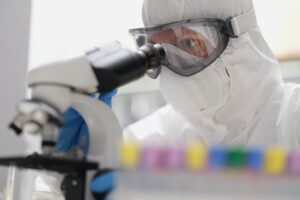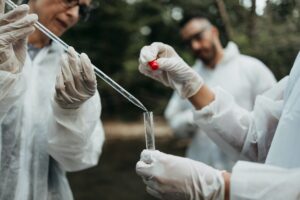Table of Contents
When it comes to pharmaceuticals, ensuring quality and safety is of paramount importance. One crucial aspect of this process is sterility testing. In this article, we will dive into the intricate details of sterility testing and explore its significance in the pharmaceutical industry.
Sterility testing is a stringent procedure that involves determining the absence of viable microorganisms in pharmaceutical products. This testing plays a vital role in guaranteeing the sterility and safety of drugs, injectables, and medical devices. By subjecting the products to a variety of culture media and incubation conditions, sterility testing checks for any potential contamination that could harm patients.
The process of sterility testing involves various steps, including sample preparation, filtration, inoculation, and incubation. Each step requires precision, attention to detail, and adherence to strict guidelines to ensure accurate and reliable results. By following these processes diligently, pharmaceutical companies can provide high-quality, safe products to consumers.
With advancing technology and increasing regulatory scrutiny, sterility testing continues to evolve. Innovations in automated testing and rapid microbial detection methods are enhancing the efficiency and reliability of the process. These advancements hold the promise of further improving the safety and quality of pharmaceutical products in the future.
In conclusion, sterility testing is a critical procedure that pharmaceutical companies undertake to ensure the quality and safety of their products. By adhering to stringent testing protocols and embracing technological advancements, the industry can continue to provide reliable and safe medications to millions of people worldwide.
Regulatory guidelines for sterility testing
Sterility testing is a critical aspect of pharmaceutical manufacturing for several reasons. Firstly, it ensures that pharmaceutical products are free from harmful microorganisms that could cause infections or other adverse reactions in patients. By subjecting the products to sterility testing, pharmaceutical companies can identify any potential contamination and take appropriate measures to rectify the issue.
Secondly, sterility testing is required by regulatory authorities worldwide. Regulatory guidelines, such as those set by the United States Pharmacopeia (USP) and the European Pharmacopoeia (EP), mandate sterility testing as a part of the quality control process for pharmaceutical products. Compliance with these guidelines is essential for product approval and market authorization.
Moreover, sterility testing helps pharmaceutical companies maintain their reputation and credibility. By consistently producing sterile and safe products, companies can build trust with healthcare professionals and patients. This trust is crucial for the success and sustainability of pharmaceutical businesses.
Sterility testing methods and techniques
Regulatory agencies play a significant role in ensuring the safety and quality of pharmaceutical products. They provide guidelines and standards for sterility testing to ensure consistency and reliability across the industry. Some of the key regulatory guidelines for sterility testing include those outlined by the USP, EP, and the International Organization for Standardization (ISO).
The USP chapter i>“a href=”https://www.uspnf.com/sites/default/files/usp_pdf/EN/USPNF/revisions/general-chapter-71-microbiological-examination-of-nonsterile-products-microbial-enumeration-tests-2020-04.pdf” target=”_blank”>General Chapter <71> Microbiological Examination of Nonsterile Products: Microbial Enumeration Tests/a>”/i> provides detailed procedures and acceptance criteria for sterility testing. It covers aspects such as sample preparation, test methods, and interpretation of results. Adhering to these guidelines is essential for pharmaceutical companies seeking regulatory approval.
Similarly, the EP i>“a href=”https://www.edqm.eu/en/european-pharmacopoeia-ph-eur-10″ target=”_blank”>Pharmacopoeia/a>”/i> provides guidelines for sterility testing in Europe. It outlines the requirements for test methods, containers, and sample sizes. Compliance with these standards is crucial for ensuring product safety and market access in European countries.
The ISO, through its i>“a href=”https://www.iso.org/standard/77291.html” target=”_blank”>ISO 11737-2:2019/a>”/i> standard, specifies the methods for determining the bioburden of medical devices. This standard is widely used in the industry to assess the microbial contamination of medical devices and ensure their sterility.
Sample collection and preparation for sterility testing
Sterility testing can be performed using different methods and techniques, depending on the product type and regulatory requirements. The two primary methods used in sterility testing are membrane filtration and direct inoculation.
Membrane filtration involves passing a known volume of the sample through a sterile membrane filter. The filter retains any microorganisms present in the sample while allowing the sterile liquid to pass through. The filter is then placed on a suitable culture medium and incubated to promote the growth of any trapped microorganisms. After the incubation period, the filter is examined for the presence of microbial colonies.
Direct inoculation, on the other hand, involves directly adding the sample to a culture medium. This method is typically used for products that cannot be filtered, such as ointments and creams. The samples are inoculated into various culture media and incubated to detect any microbial growth.
Additionally, rapid microbial detection methods, such as polymerase chain reaction (PCR) and nucleic acid amplification techniques, are gaining popularity in sterility testing. These methods provide faster results and can detect a broader range of microorganisms compared to traditional culture-based methods.
Sterility testing process and equipment
Accurate sample collection and preparation are crucial for reliable sterility testing results. Samples should be collected aseptically using appropriate sampling techniques and containers. It is essential to ensure that the sampling process does not introduce any contamination.
Once collected, the samples need to be handled carefully to prevent any microbial growth or contamination. Samples may need to be homogenized or diluted before testing, depending on their nature and the testing method employed. The use of sterile equipment and proper aseptic techniques is essential during sample preparation to maintain the integrity of the samples and ensure accurate test results.
Common challenges and troubleshooting in sterility testing
The sterility testing process involves several key steps, each of which plays a crucial role in determining the absence of viable microorganisms in the pharmaceutical products. These steps include:
1. Sample Preparation: As mentioned earlier, sample preparation involves handling and processing the samples to ensure accurate and representative testing. This step requires adherence to aseptic techniques and the use of appropriate equipment.
2. Filtration or Direct Inoculation: Depending on the method chosen, the samples are either filtered through a membrane filter or directly inoculated into culture media. This step aims to capture any microorganisms present in the sample.
3. Incubation: After filtration or inoculation, the culture media containing the samples are incubated under appropriate conditions to promote the growth of any viable microorganisms. Incubation periods may vary depending on the regulatory guidelines and the nature of the product being tested.
4. Microbial Examination: Following the incubation period, the culture media are examined for the presence of microbial growth. This examination can be done visually or by using automated systems that detect microbial growth. Any observed growth is further analyzed and identified to determine its significance.
Validation and qualification of sterility testing methods
Despite strict adherence to guidelines and best practices, sterility testing can present challenges. Some common challenges include:
1. Contamination: Contamination can occur at any stage of the testing process, leading to false-positive results. It is crucial to maintain proper aseptic techniques, handle samples carefully, and regularly monitor the sterility of the testing environment and equipment.
2. Slow Growth or No Growth: Some microorganisms may have slow growth rates or may not grow under the incubation conditions used in sterility testing. This can lead to false-negative results. Validation studies should be conducted to ensure the appropriateness of the chosen incubation conditions.
3. Interference from Product Components: Certain product components, such as preservatives or antimicrobial agents, can interfere with microbial growth, leading to inaccurate results. It is important to consider these factors during method development and validation.
Troubleshooting such challenges involves careful investigation, data analysis, and continuous improvement of the testing processes. Regular training of personnel, equipment maintenance, and environmental monitoring are essential for minimizing these challenges and ensuring accurate results.
Best practices for sterility testing in pharmaceuticals
Validation and qualification of sterility testing methods are essential to ensure the reliability and accuracy of the results. Validation studies involve demonstrating the effectiveness of the chosen method in detecting microorganisms and evaluating its specificity, sensitivity, and robustness.
Qualification studies, on the other hand, focus on ensuring that the testing equipment, facilities, and personnel meet the required standards for sterility testing. This includes verifying the performance of incubators, filters, culture media, and other equipment used in the process.
Validation and qualification studies are typically conducted during method development and are periodically reviewed to ensure the continued suitability of the methods and equipment. These studies provide confidence in the reliability and accuracy of sterility testing results.
Conclusion
To ensure the highest quality and safety of pharmaceutical products, adherence to best practices in sterility testing is essential. Some key best practices include:
1. Training and Qualification: Personnel involved in sterility testing should receive adequate training on aseptic techniques, sample handling, and testing procedures. Regular qualification and competency assessments should be conducted to ensure the proficiency of the testing personnel.
2. Environmental Monitoring: Regular monitoring of the testing environment is crucial to identify and control potential sources of contamination. This includes monitoring air quality, surface cleanliness, and the sterility of the equipment used in the testing process.
3. Quality Control: Implementation of robust quality control measures, including regular calibration of equipment, routine testing of culture media, and monitoring of incubation conditions, is vital for ensuring the reliability and accuracy of sterility testing results.
4. Risk Assessment: Conducting risk assessments to identify potential sources of contamination and implementing appropriate mitigation strategies is essential. This includes assessing the risks associated with sample collection, transportation, and storage, as well as identifying potential sources of microbial contamination within the manufacturing process.
5. Continuous Improvement: Regular review and evaluation of sterility testing processes, methods, and equipment are necessary to identify areas for improvement. This ensures that the testing procedures remain up-to-date and aligned with the latest regulatory requirements and technological advancements.






